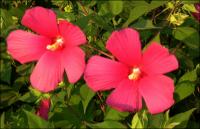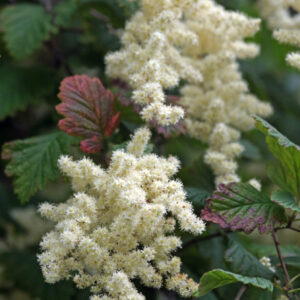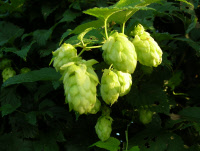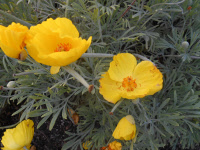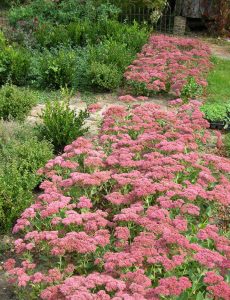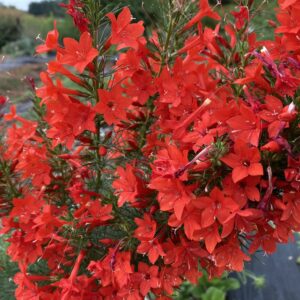Plants for Butterflies and Other Pollinators
Showing 97–104 of 211 results
-
Hibiscus moscheutos Rose mallow Z 5-9
August and September, bodacious, white, pink or crimson platters, looking like the tropics.
August and September, bodacious, white, pink or crimson platters, looking like the tropics.
Size: 5-8' x 3'
Care: Sun, moist to moist well-drained soil, no staking needed.
Native: Southern U.S.
Wildlife Value: Attracts butterflies esp. Cloudless Sulphur butterflies relish Rose mallow’s nectar.One Native American tribe used this plant to cure inflamed bladders. 1st collected by Rev. John Banister (1649-1692) who moved to colonial Virginia in 1678. A gunman mistakenly shot and killed him while he collected plants. Cultivated by Lady Skipworth in her colonial Virginia garden. Bloomed for Jefferson in July, 1767. Grown at America’s 1st botanic garden, Elgin Botanic Garden 1811.
-
Holodiscus discolor Creambush, Ocean spray Z 5-10
Multistemmed shrub with dense, elegant pyramidal clusters of arching cream-colored flowers in early to mid summer. Leaves tint red in fall.
OUT OF STOCK
Multi-stemmed shrub with dense, elegant pyramidal clusters of arching cream-colored flowers in early to mid-summer. Leaves tint red in fall.
Size: 4-8’ x 8’
Care: sun to part shade in moist to moist well-drained soil
Native: Montana to Colorado west to the Pacific.
Wildlife Value: nectar for hummingbirds, food for butterfly caterpillars, bird habitat.Hard and durable wood was used to make digging sticks, spears, harpoon shafts, bows, and arrows by nearly all coastal Native groups. A few used the wood to make sticks to barbeque salmon, fish hooks, needles for weaving and knitting, Pegs were made to use like nails. Others made wood intoarmor plating and canoe paddles.
A few Natives made an infusion of boiled fruit to cure diarrhea, measles, chickenpox and as a blood tonic. Collected by Meriwether Lewis in today’s Idaho on the Clearwater River, May 29, 1806 en route back east on the Lewis and Clark Expedition. -
Humulus lupulus Hops Z 3-8
In August green turning to straw-colored papery hops dangle from this vigorous vine.
In August green turning to straw-colored papery hops dangle from this vigorous vine.
Size: 20' x 3'
Care: Sun to part shade in moist, humusy soil but tolerates dry shade.
Native: Europe
Wildlife Value: attracts Eastern comma & Red admiral butterfliesLupulus named for the Latin Lupis, meaning wolf “because the ancients had a notion that wolves hid themselves under this plant.” Gardeners Dictionary, 1768. Used for brewing since ancient times. Transported from continental Europe to England in 1524. Added to ale for flavor and as a preservative. In the late 1500’s Gerard claimed that hops seasoned ale and ”make it a physical drinke to keep the body in health, rather than an ordinary drinke for the quenching of our thirst… The buds or first sprouts which come forth in the Spring are used to be eaten in sallads… The floures are vsed to season Beere or Ale with, and too many do cause bitternesse thereof… The floures make bread light, and the lumpe to be sooner and easilier leauened, if the meale be tempered with liquor wherein they haue been boyled.” Russians crowned the heads of brides with its foliage to bring “joy, abundance and intoxication.” Others put dried hops into pillows to relieve insomnia. Imported to America by the mid 1600’s where it was used to provide shade and to make beer. Cherokee adopted hops to relieve pain caused by rheumatism. Grown by Jefferson.
-
Hunnemannia fumariifolia Goldencup, Mexican Tulip Poppy Z 9-11, Annual in colder areas
All summer and fall sunny, crepe-papery petals with jagged edges center around orange anthers all carried above thin-leaved blue-grey foliage.
OUT OF STOCK – EMAIL FOR AVAILABILITY
All summer and fall sunny, crepe-papery petals with jagged edges center around orange anthers all carried above thin-leaved blue-grey foliage.
Size: 6-12" x 6-12"
Care: sun in moist, well-drained to well-drained soil
Native: highlands of Mexico, TX, NM & AZDescribed and named by English botanist Robert Sweet (1783-1835) in The British Flower Garden vol. 3 (1828). Named for John Hunnemannia
-
Hylotelephium herbstsfreude syn Sedum ‘Autumn Joy’ Z 4-9
Classic, large flat flower heads turn from green to rose
Classic, large flat flower heads turn from green to rose blooming in September and October. A staple for autumn in the garden.
Size: 30” x 12”
Care: full sun in well-drained soil
Wildlife Value: Attracts many bees and butterflies. Black walnut tolerant, deer resistant.
Awards: England’s Royal Horticultural Society Award of Garden Merit.Autumn Joy introduced to gardens before 1920 by the George Arends Nursery in Ronsdorf, Germany.
-
Ipomopsis aggregata Standing cypress, Skyrocket, Scarlet gilia Z 4-11 Reseeding biennial
Many attention-grabbing, cardinal red trumpets on a leafless spike in summer-fall gardens
Many attention-grabbing, cardinal red trumpets on a leafless spike in summer-fall gardens
Size: 3-5’ x 12”
Care: sun to part shade in moist well-drained to well-drained soil
Native: west from ND, south to TX to the Pacific Ocean, also western Canada
Wildlife Value: attracts bees, Swallowtail butterflies and flocks of hummingbirds. Deer resistant.Hopi made it into decorations and dye. Klamath children sucked its nectar from the flowers. Navajo remedied many ailments with this – spider bites. stomach ailments by induce purging. And they grew it for its beauty. Canada’s Salish washed their face, hair, and eyes with this. Shoshone remedied pains of rheumatism by crushing the plants and applying it to the aches. Also a remedy sexually transmitted diseases, itches, tonic for blood and induce vomiting,
Collected by Meriwether Lewis on the Lolo Trail crossing the Bitterroot Range of the Rockies, June 26 1806. Named and described initially by Frederick Pursh in Flora Americae Septronalis Vol1 p. 147 (1813) from the plant collected by Lewis on the Lewis and Clark Expedition. -
Iris ‘Spark’ Z 4-8
Early blooming, intermediate bearded iris of brick-red standards and burgundy falls with a bright spark of a beard in the middle.
Early blooming, intermediate bearded iris of brick-red standards and burgundy falls with a bright spark of a beard in the middle.
Size: 23” x 12”
Care: sun in moist well-drained soil.
Wildlife Value: Welcomes bees with easy access to pollen.Iris is named after the Greek goddess who accompanied the souls of women to the Elysian Fields by way of the rainbow. Her footprints left flowers the colors of the rainbow. Iris means the eye of heaven. The iris is the flower of chivalry, having “a sword for its leaf and a lily for its heart.” Ruskin. Spark hybridized and introduced by Col. J. C. Nicholls in 1931,
-
Iris missouriensis Western blue flag, Rocky Mountain iris Z 3-8
In spring variegated, violet blue iris flowers - 6 perianth segments, 3 spreading to reflexed falls with a dark yellow-orange stripe down the middle with blue lines on a white background, & 3 purple standards.
In spring variegated, violet blue iris flowers – 6 perianth segments, 3 spreading to reflexed falls with a dark yellow-orange stripe down the middle with blue lines on a white background, & 3 purple standards.
Size: 12-24” x 9-12”
Care: sun to part shade in moist well-drained to moist soil. Divide regularly.
Native: Alberta and British Columbia, from Minnesota to Washington south to California east to New Mexico
Wildlife Value: Deer resistant. Attracts hummingbirds, provides pollen to bees.Named for the Missouri River although ironically Lewis collected it along the Blackfoot River in today’s Montana on July 5, 1806.
Paiute Indians of eastern California and southeastern Oregon made ear drops to remedy earaches with a decoction if the Iris roots.

